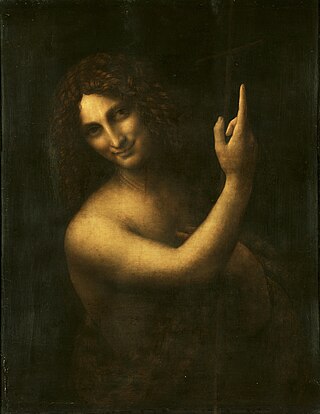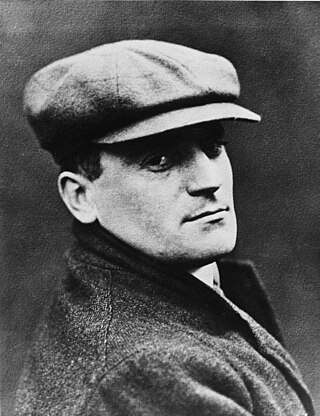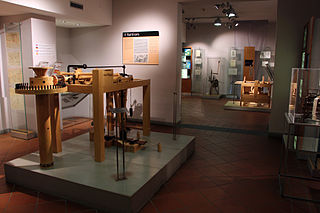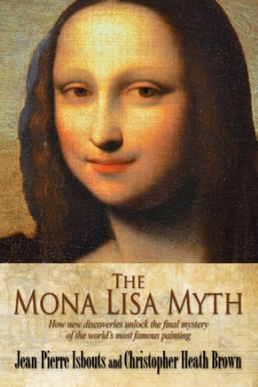Related Research Articles

The Mona Lisa is a half-length portrait painting by Italian artist Leonardo da Vinci. Considered an archetypal masterpiece of the Italian Renaissance, it has been described as "the best known, the most visited, the most written about, the most sung about, [and] the most parodied work of art in the world". The painting's novel qualities include the subject's enigmatic expression, monumentality of the composition, the subtle modelling of forms, and the atmospheric illusionism.
Lillian F. Schwartz is an American artist considered a pioneer of computer-mediated art and one of the first artists notable for basing almost her entire oeuvre on computational media. Many of her ground-breaking projects were done in the 1960s and 1970s, well before the desktop computer revolution made computer hardware and software widely available to artists.

Saint John the Baptist is a High Renaissance oil painting on walnut wood by Leonardo da Vinci. Likely to have been completed between 1513 and 1516, it is believed to be his final painting. Its original size was 69 by 57 centimetres.

Leonardo da Vinci was an Italian Renaissance painter and polymath who achieved legendary fame and iconic status within his own lifetime. His renown primarily rests upon his brilliant achievements as a painter, the Mona Lisa and The Last Supper, being two of the most famous artworks ever created, but also upon his diverse skills as a scientist and inventor. He became so highly valued during his lifetime that the King of France bore him home like a trophy of war, supported him in his old age and, according to legend, cradled his head as he died.

The Isleworth Mona Lisa is an early 16th-century oil on canvas painting depicting the same subject as Leonardo da Vinci's Mona Lisa, though with the subject depicted as being a younger age. The painting is thought to have been brought from Italy to England in the 1780s, and came into public view in 1913 when the English connoisseur Hugh Blaker acquired it from a manor house in Somerset, where it was thought to have been hanging for over a century. The painting would eventually adopt its unofficial name of Isleworth Mona Lisa from Blaker's studio being in Isleworth, West London. Since the 1910s, experts in various fields, as well as the collectors who have acquired ownership of the painting, have asserted that the major elements of the painting are the work of Leonardo himself, as an earlier version of the Mona Lisa.

Marco d'Oggiono was an Italian Renaissance painter and a chief pupil of Leonardo da Vinci, many of whose works he copied.

L.H.O.O.Q. is a work of art by Marcel Duchamp. First conceived in 1919, the work is one of what Duchamp referred to as readymades, or more specifically a rectified ready-made. The readymade involves taking mundane, often utilitarian objects not generally considered to be art and transforming them, by adding to them, changing them, or simply renaming and reorienting them and placing them in an appropriate setting. In L.H.O.O.Q. the found object is a cheap postcard reproduction of Leonardo da Vinci's early 16th-century painting Mona Lisa onto which Duchamp drew a moustache and beard in pencil and appended the title.

The 16th-century portrait Mona Lisa, or La Gioconda, painted in oil on a poplar panel by Leonardo da Vinci, has been the subject of a considerable deal of speculation.

Vandalism of art is intentional damage of an artwork. The object, usually exhibited in public, becomes damaged as a result of the act, and remains in place right after the act. This may distinguish it from art destruction and iconoclasm, where it may be wholly destroyed and removed, and art theft, or looting.
Specular holography is a technique for making three dimensional imagery by controlling the motion of specular glints on a two-dimensional surface. The image is made of many specularities and has the appearance of a 3D surface-stippling made of dots of light. Unlike conventional wavefront holograms, specular holograms do not depend on wave optics, photographic media, or lasers.

Gian Giacomo Caprotti da Oreno, better known as Salaì was an Italian artist and pupil of Leonardo da Vinci from 1490 to 1518. Salaì entered Leonardo's household at the age of ten. He created paintings under the name of Andrea Salaì. He was described as one of Leonardo's students and lifelong companion and servant and was the model for Leonardo's St. John the Baptist,Bacchus and Angelo incarnato.

Hugh Blaker (1873–1936) was an English artist, collector, connoisseur, dealer in Old Masters, museum curator, writer on art, and a supporter and promoter of modern British and French painters.

Salvator Mundi is a painting attributed in whole or in part to the Italian High Renaissance artist Leonardo da Vinci, dated to c. 1499–1510. Long thought to be a copy of a lost original veiled with overpainting, it was rediscovered, restored, and included in an exhibition of Leonardo's work at the National Gallery, London, in 2011–2012. Christie's, who sold the work in 2017, stated that most leading scholars consider it an original work by Leonardo, but this attribution has been disputed by other leading specialists, some of whom propose that he only contributed certain elements; and others who believe that the extensive restoration prevents a definitive attribution.
Leonardo da Vinci's Mona Lisa is one of the most recognizable and famous works of art in the world, and also one of the most replicated and reinterpreted. Mona Lisa replicas were already being painted during Leonardo's lifetime by his own students and contemporaries. Some are claimed to be the work of Leonardo himself, and remain disputed by scholars. Prominent 20th-century artists such as Marcel Duchamp and Salvador Dalí have also produced derivative works, manipulating Mona Lisa's image to suit their own aesthetic. Replicating Renaissance masterpieces continues to be a way for aspiring artists to perfect their painting techniques and prove their skills.

A paintings conservator is an individual responsible for protecting cultural heritage in the form of painted works of art. These individuals are most often under the employ of museums, conservation centers, or other cultural institutions. They oversee the physical care of collections, and are trained in chemistry and practical application of techniques for repairing and restoring paintings.

The Museo Ideale Leonardo da Vinci is located in Vinci, Leonardo da Vinci's birthplace, in the province of Florence, Italy. It is part of the Museo leonardiano di Vinci.
Jean-Pierre Isbouts is a professor in the Social Sciences PhD program of Fielding Graduate University in Santa Barbara, California, and an archaeologist, author, screenwriter, director, and producer of works addressing various historical periods, particularly the time period of Jesus and that of Renaissance and post-Renaissance art.

The two–Mona Lisa theory is a longstanding theory proposed by various historians, art experts, and others that Leonardo da Vinci painted two versions of the Mona Lisa. Several of these experts have further concluded that examination of historical documents indicates that one version was painted several years before the second.

Dr. Henry Franz Pulitzer (1899–1979) was an Austrian-born gallery owner and "avid art collector", and connoisseur, described by one source as a "media mogul". He was the owner of the Pulitzer galleries in London and Bern, Switzerland, and of the Isleworth Mona Lisa, a painting famous for the claim passed down from its previous owners that there was evidence that it was painted by Leonardo da Vinci. Pulitzer himself took up the cause of proving the claimed provenance of the painting, including writing a book in support of it, but his efforts did not lead to acceptance of the claim during his lifetime.

The Mona Lisa Myth is a multimedia project consisting of a 2013 book and a 2014 documentary film, produced in tandem by Renaissance scholar and art historian Jean-Pierre Isbouts, with physician and art collecter Christopher Heath Brown as co-author of the book and as a producer of the documentary, the latter with narration by Morgan Freeman. The book and film each examine the history of the Mona Lisa, and the longstanding theory that the Isleworth Mona Lisa is an earlier version of the same painting, also by Leonardo da Vinci.
References
- ↑ "People - John Asmus - Brief Bio". UC San Diego - Center for Advanced Nanoscience.
- 1 2 3 4 5 Mary S. Rauch, "The Newest in Science is Working To Save the Oldest in Art", Newport News Daily Press (December 28, 1980), Parade p. 16.
- ↑ Bordalo, Rui (June 4, 2009). "LACONA VII Proceedings: Lasers in the Conservation of Artworks". eConservation Magazine. Archived from the original on May 22, 2009.
- ↑ "Laser Photography May Preserve Art", The Indianapolis Star (March 31, 1972), p. 36.
- ↑ "A Benevolent Beam", San Francisco Examiner (September 2, 1973), p. 30.
- ↑ Everett Holles, "Search For a Lost da Vinci", San Francisco Examiner (August 10, 1975), p. 19.
- ↑ "Laser finds Capitol art", The Berkeley Gazette (April 26, 1978), p. 26.
- ↑ de Leschery, Karen (2001). "John Fredrich Asmus: Project". Rolex Awards for Enterprise.
- ↑ Spie (2014). "John Asmus: Optical techniques and the mysterious Mona Lisa". SPIE Newsroom. doi:10.1117/2.3201403.08.
- 1 2 Mark Roth, "Uncovering the Mona Lisa", Pittsburgh Post-Gazette (March 2, 1987), p. 1.
- 1 2 "Analysis of Mona Lisa turns up surprises", Indiana Gazette (May 20, 1996), p. 5.
- 1 2 3 Kristine Moe, "Expert plans facelift for ancient Chinese artwork", Hazleton Standard-Speaker (December 8, 1987), p. 27.
- ↑ John F. Asmus, "Computer Studies of the Isleworth and Louvre Mona Lisas", in T. Russell Hsing and Andrew G. Tescher, Selected Papers on Visual Communication: Technology and Applications (SPIE Optical Engineering Press, 1990), p. 652-656; reprinted from Optical Engineering, Vol. 28(7) (July 1989), p. 800-804.
- ↑ "Rolex Awards for Enterprise". Rolex Awards for Enterprise : Profiles in A-F.
- ↑ Asmus, John F.; Parfenov, Vadim; Elford, Jessie (28 November 2016). "Seeing double: Leonardo's Mona Lisa twin". Optical and Quantum Electronics. 48 (12): 555. doi:10.1007/s11082-016-0799-0. S2CID 125226212.
- ↑ Boudin de l'Arche, Gerard (2017). A la recherche de Monna Lisa. Cannes, France: Edition de l'Omnibus. ISBN 9791095833017.
- ↑ "New proof said found for "original" Mona Lisa –". Reuters.com. 13 February 2013. Retrieved 26 July 2017.
- ↑ Asmus, John F.; Parfenov, Vadim (December 28, 2018). "Characterization of Rembrandt self-portraits through digital-chiaroscuro statistics". Journal of Cultural Heritage.